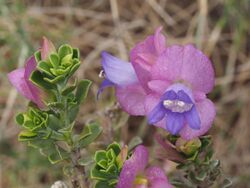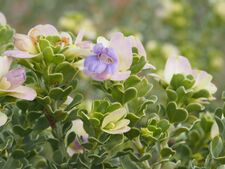Biology:Eremophila cuneifolia
| Pinyuru | |
|---|---|

| |
| Eremophila cuneifolia - form with colourful sepals | |
| Scientific classification | |
| Kingdom: | Plantae |
| Clade: | Tracheophytes |
| Clade: | Angiosperms |
| Clade: | Eudicots |
| Clade: | Asterids |
| Order: | Lamiales |
| Family: | Scrophulariaceae |
| Genus: | Eremophila |
| Species: | E. cuneifolia
|
| Binomial name | |
| Eremophila cuneifolia Kraenzl.[1]
| |
Eremophila cuneifolia, commonly known as pinyuru,[2] is a flowering plant in the figwort family, Scrophulariaceae and is endemic to the north-west of Western Australia. It is a spreading, sticky shrub with wedge-shaped leaves, coloured sepals and usually deep purple flowers.
Description
Eremophila cuneifolia is a spreading shrub growing to a height of between 0.4 and 1.8 metres (1 and 6 ft) with hairy branches and with branches and leaves that are thickly covered with sticky, shiny resin. The leaves are arranged alternately and clustered near the ends of the stems, mostly 5–16 millimetres (0.2–0.6 in) long, about 3–14 millimetres (0.1–0.6 in) wide, wedge-shaped or heart-shaped but with a distinct small point at the tip. They are thick and stiff and the top surface of the leaves is glabrous while the lower surface is hairy.[3][4]
The flowers are borne singly in leaf axils on hairy stalks 1–3.5 millimetres (0.04–0.1 in) long. There are five cream-coloured to pale reddish-purple, slightly overlapping, egg-shaped sepals differing in size from each other but mostly 8.5–26 millimetres (0.3–1 in) long. The petals are 16–26 millimetres (0.6–1 in) long and joined at their lower end to form a tube. The petal tube is usually deep purple on the outside, sometimes paler, and white inside with purple spots. There are scattered hairs on the outside of the tube and on the lobes but the tube is filled with long, soft hairs. The four stamens are fully enclosed within the tube. Flowering occurs mostly from June to October and is followed by fruits which are oval to cone-shaped, shiny and 5.5–9 millimetres (0.2–0.4 in) long.[3][4]

thumb|225px|Habit near the Kennedy Range
Taxonomy and naming
The species was first formally described by Friedrich Wilhelm Ludwig Kraenzlin in 1929 and the description was published in Repertorium Specierum Novarum Regni Vegetabilis Beihefte.[5] The type specimen was collected by the explorer Charles Crossland, near Mount Hale on the upper reaches of the Murchison River, about 140 kilometres (90 mi) west north west of Meekatharra.[5][3][4] The specific epithet (cuneifolia) is from the Latin words cuneus meaning "wedge"[6]:216 and folium meaning "a leaf".[6]:466
Distribution
Pinyuru occurs between Leonora, Jigalong and Onslow[4] in the Carnarvon, Little Sandy Desert, Central Ranges, Murchison, Pilbara and Gascoyne biogeographic regions.[2] It grows in a range of soils and habitats, often in association with other Eremophila species and is sometimes the dominant plant species.[3][7]
Conservation status
Eremophila cuneifolia is classified as "not threatened" by the Government of Western Australia Department of Parks and Wildlife.[2]
Use in horticulture
This is one of the most attractive eremophilas in cultivation with its colourful sepals and deep purple flowers. It is not easy to propagate or to maintain, especially in areas like Sydney where the humidity is high. It is usually propagated by grafting onto Myoporum and needs a well-drained soil. Pinyuru is also frost sensitive and for this reason is probably best grown in a container which can be moved as the seasons change.[8]
References
- ↑ "Eremophila cuneifolia". Australian Plant Census. https://biodiversity.org.au/nsl/services/apc-format/display/113095. Retrieved 10 April 2020.
- ↑ 2.0 2.1 2.2 "Eremophila cuneifolia". FloraBase. Western Australian Government Department of Parks and Wildlife. https://florabase.dpaw.wa.gov.au/browse/profile/7192.
- ↑ 3.0 3.1 3.2 3.3 Chinnock, R.J. (Bob) (2007). Eremophila and allied genera : a monograph of the plant family Myoporaceae (1st ed.). Dural, NSW: Rosenberg. pp. 341–342. ISBN 9781877058165.
- ↑ 4.0 4.1 4.2 4.3 Brown, Andrew; Buirchell, Bevan (2011). A field guide to the eremophilas of Western Australia (1st ed.). Hamilton Hill, W.A.: Simon Nevill Publications. p. 73. ISBN 9780980348156.
- ↑ 5.0 5.1 "Eremophila cuneifolia". APNI. http://id.biodiversity.org.au/name/apni/113095. Retrieved 5 January 2016.
- ↑ 6.0 6.1 Brown, Roland Wilbur (1956). The Composition of Scientific Words. Washington, D.C.: Smithsonian Institution Press.
- ↑ Paczkowska, Grazyna; Chapman, Alex R. (2000). The Western Australian flora : a descriptive catalogue. Perth: Wildflower Society of Western Australia. p. 334. ISBN 0646402439.
- ↑ Boschen, Norma; Goods, Maree; Wait, Russell (2008). Australia's eremophilas : changing gardens for a changing climate. Melbourne: Bloomings Books. pp. 81–83. ISBN 9781876473655.
Wikidata ☰ Q5385559 entry
 |


